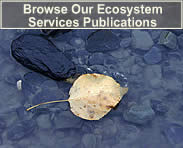
Neighborhood Trees
Healthy trees are valuable assets for communities. Urban and community forests contribute to energy savings, better air and water quality, reduced storm water runoff, carbon storage, and increased property values. Street trees and parks moderate local climate and provide aesthetic and recreational values to communities.
As natural elements of a built landscape, trees improve urban life and are critical to human health and emotional well-being. Research suggests that human beings have an innate affiliation to natural settings – a concept described as biophilia. Numerous studies link access to natural light, outdoor air, and living trees to increased employee and student productivity, faster hospital recoveries, less crime, and an overall reduction in stress and anxiety.
In an effort to maintain and improve the public benefits of trees, more and more cities throughout the United States are setting tree canopy goals. Community forests are becoming incorporated in sustainable growth strategies that seek to provide elements of green space – parks, gardens, farmlands, and other open areas. Investments in protected “green infrastructure” – strategically planned and locally managed networks of open green space – connect people to nature and to each other, providing a higher quality of life for community residents.
Greening our cities…
Some of the organizations dedicated to increasing urban tree cover and green space:
- Atlanta: Georgia Urban Forest Council
- Chicago: Openlands Project
- Baltimore: TreeBaltimore
- Boston: Boston Urban Forest Coalition
- New York: MillionTreesNYC
- Los Angeles: Million Trees LA
- Sacramento: Sacramento Tree Foundation
- Washington DC: Casey Trees Endowment Fund
Feature Publications
- Urban Tree Planting and Greenhouse Gas Reductions (McPherson 2007)(
 PDF, 65 KB)
PDF, 65 KB)
- The potential of urban tree plantings to be cost effective in carbon credit markets (McHale, MacPherson, and Burke 2007)(
 PDF, 254 KB)
PDF, 254 KB) - Talking Trees: An Urban Forestry Toolkit for Local Governments (ICLEI - Local Governments for Sustainability 2006)(
 PDF, 0.9 MB)
PDF, 0.9 MB) - Urban Tree Canopy Goal Setting: A Guide for Chesapeake Bay Communities (Raciti et al. 2006)(
 PDF, 10.8 MB)
PDF, 10.8 MB) - Urban Forestry in North America (McPherson 2006)(
 PDF, 0.8 MB)
PDF, 0.8 MB) - Cooperating Across Boundaries: Partnerships to conserve open space in rural America (USFS 2006)
- Carbon Accounting Rules and Guidelines for the United States Forest Sector (Birdsey 2006)(
 PDF, 82 KB)
PDF, 82 KB) - Economic Development and Smart Growth: 8 Case Studies on the Connections between Smart Growth Development and Jobs, Wealth, and Quality of Life in Communities (
 PDF, 3.1 MB)
PDF, 3.1 MB) - The Conservation Fund: Green Infrastructure (Benedict and McMahon, 2006)
- Projected Urban Growth (2000–2050) and Its Estimated Impact on the US Forest Resource (Nowak and Walton 2005)(
 PDF, 2.5 MB)
PDF, 2.5 MB) - Last Child in the Woods: Saving Our Children from Nature-Deficit Disorder (Louv 2005)
- Forests on the Edge: Housing Development on America’s Private Forests (US Forest Service 2005)(
 PDF, 2.6 MB)
PDF, 2.6 MB) - Urban Watershed Forestry Manual (Center for Watershed Protection and US Forest Service 2005)
- Natural Cities: Urban Ecology and the Restoration of Urban Ecosystems (Lord et al. 2002)(
 PDF, 290 KB)
PDF, 290 KB) - The Biophilia Hypothesis (Kellert and Wilson, eds. 1993)
Helpful Websites
- US Forest Service:
- Tree link
- Alliance for Community Trees
- American Forests
- GreenInfrastructure.net
- Urban Land Institute
- The Landscape and Human Health Laboratory
- Urban Tree Cover and Air Quality Planning
Useful Tools
Location: http://www.fs.fed.us/ecosystemservices/trees.shtml
Updated: September 23, 2008 9:32 AM


